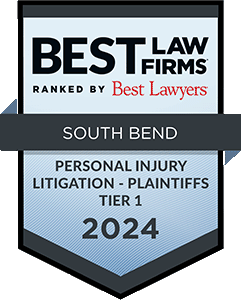Reasonable person standards help identify fault in car accidents, slip and falls and other personal injury cases. This legal benchmark can help victims seek compensation after a personal injury case.
Table of Contents
If you were injured in an accident caused by another person’s negligence, you may have the right to pursue compensation. Our South Bend personal injury lawyers have over 170 years of combined experience serving injury victims and their families.
Find out if you have a case by calling: 574-444-0741.
What Is the Reasonable Person Standard?

The reasonable personal standard measures whether an individual’s behaviors meet the expectations of what an average person would do in a similar circumstance. For example, the average driver will stop at a red light to avoid a car accident. However, if someone runs a red light, they do not meet the expectation of what a reasonable person would have done. This legal benchmark determines whether someone’s actions were negligent, making someone liable for causing harm.
How Is The Reasonable Person Standard Applied To Determine Liability
The reasonable person standard in South Bend is fundamental in negligence cases. It is a core component in identifying who is at fault for the damages. The process involves these steps:
Assessing Duty of Care
Duty of care is the obligation that requires someone not to cause harm to others. This obligation may differ depending on the scenario. For example, a doctor has the duty of care to keep their patient safe during surgery. Business owners or workers also have the duty of care to keep their business safe for customers and occupants.
Evaluating Breach of Duty
Breach of duty occurs when an individual fails to meet the required standard of care. For example, if a driver runs a red light and causes an accident, he or she has breached their duty to prevent causing harm to others.
Determining Causation
Even if a defendant’s actions were unreasonable, the attorney must be able to prove that they directly caused your injury. This involves proving that the breach of duty was a substantial factor in causing the harm.
Proving Damages
Finally, the injured party must show that they suffered damages due to the defendant’s negligent behavior. This might include medical expenses, lost wages, and pain and suffering.
Examples of the Reasonable Person Standard Personal Injury Cases
These are common scenarios where the reasonable person standard could apply.
Car Accidents
If you were injured in a car accident caused by a speeding driver, the insurance company would determine whether a reasonable driver would have been speeding in that situation. They would focus on whether the driver acted reasonably.
Slip and Fall Incidents
If you slipped and fell on a wet floor in a store, the reasonable person standard would examine whether the store owner took adequate steps to ensure the floor was safe. For instance, a reasonable store owner would promptly place warning signs to prevent someone from getting injured.
Medical Malpractice
In medical malpractice cases, the standard assesses whether a healthcare provider acted the same as a reasonable provider would have been in a similar situation. This involves evaluating whether the provider followed established medical guidelines or procedures.
How the Reasonable Person Standard Influences Your Case
Several factors influence how the reasonable person standard is applied in Indiana injury cases. Some of these aspects include:
The Circumstances
The context in which the actions occurred plays a significant role. What is deemed reasonable in a particular situation might differ from what is considered reasonable in another. For example, what is expected of a driver in clear weather conditions may vary from what is expected in a heavy rainstorm.
Expert Testimony
Expert witnesses testify about what a reasonable person would have done. This is common in complex cases like medical malpractice, where specialized knowledge is required to determine appropriate care.
Standard Practices
Industry standards and regulations can also affect what is considered reasonable. For instance, specific safety standards in construction or manufacturing set a benchmark for what is deemed reasonable care.
Call Pfeifer, Morgan & Stesiak to Learn About You Legal Options
Seek legal assistance if you or a loved one were injured in a personal injury incident. A trusted South Bend lawyer can help you navigate your legal options.
Our firm is here to support you. At Pfeifer, Morgan & Stesiak, we can walk you through every step of the legal journey. We have a proven track record of helping our clients seek the compensation they need to recover.
Reach out to us today for a free consultation.
Call 574-444-0741 to speak to one of our lawyers.











